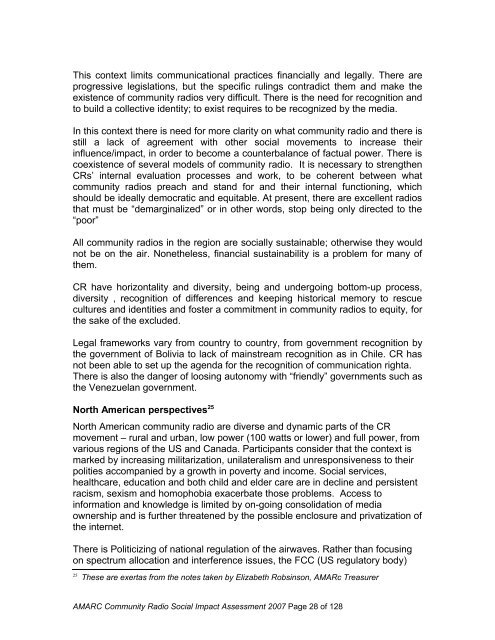Removing Barriers, Increasing Effectiveness - amarc
Removing Barriers, Increasing Effectiveness - amarc
Removing Barriers, Increasing Effectiveness - amarc
You also want an ePaper? Increase the reach of your titles
YUMPU automatically turns print PDFs into web optimized ePapers that Google loves.
This context limits communicational practices financially and legally. There areprogressive legislations, but the specific rulings contradict them and make theexistence of community radios very difficult. There is the need for recognition andto build a collective identity; to exist requires to be recognized by the media.In this context there is need for more clarity on what community radio and there isstill a lack of agreement with other social movements to increase theirinfluence/impact, in order to become a counterbalance of factual power. There iscoexistence of several models of community radio. It is necessary to strengthenCRs’ internal evaluation processes and work, to be coherent between whatcommunity radios preach and stand for and their internal functioning, whichshould be ideally democratic and equitable. At present, there are excellent radiosthat must be “demarginalized” or in other words, stop being only directed to the“poor”All community radios in the region are socially sustainable; otherwise they wouldnot be on the air. Nonetheless, financial sustainability is a problem for many ofthem.CR have horizontality and diversity, being and undergoing bottom-up process,diversity , recognition of differences and keeping historical memory to rescuecultures and identities and foster a commitment in community radios to equity, forthe sake of the excluded.Legal frameworks vary from country to country, from government recognition bythe government of Bolivia to lack of mainstream recognition as in Chile. CR hasnot been able to set up the agenda for the recognition of communication righta.There is also the danger of loosing autonomy with “friendly” governments such asthe Venezuelan government.North American perspectives 25North American community radio are diverse and dynamic parts of the CRmovement – rural and urban, low power (100 watts or lower) and full power, fromvarious regions of the US and Canada. Participants consider that the context ismarked by increasing militarization, unilateralism and unresponsiveness to theirpolities accompanied by a growth in poverty and income. Social services,healthcare, education and both child and elder care are in decline and persistentracism, sexism and homophobia exacerbate those problems. Access toinformation and knowledge is limited by on-going consolidation of mediaownership and is further threatened by the possible enclosure and privatization ofthe internet.There is Politicizing of national regulation of the airwaves. Rather than focusingon spectrum allocation and interference issues, the FCC (US regulatory body)25These are exertas from the notes taken by Elizabeth Robsinson, AMARc TreasurerAMARC Community Radio Social Impact Assessment 2007 Page 28 of 128
















